Календарь
| « Декабрь 2025 » |
|---|
| Пн | Вт | Ср | Чт | Пт | Сб | Вс |
|---|
| 1 | 2 | 3 | 4 | 5 | 6 | 7 | | 8 | 9 | 10 | 11 | 12 | 13 | 14 | | 15 | 16 | 17 | 18 | 19 | 20 | 21 | | 22 | 23 | 24 | 25 | 26 | 27 | 28 | | 29 | 30 | 31 | |
О сайте
Увлекательные фотографии и видео в удобной подаче? Запросто! Теперь мы можем Вас радовать подборками со всех сайтов которые мы посчитали интересными. Видео которое мы отбираем каждый день, убьет много свободного времени и заставит Вас поделится им с Вашими коллегами и друзьями, а в уютное время, Вы покажете это видео своим родественникам. Это все, Невседома.

|  |
 Конкурс красоты метро Конкурс красоты метро
Subways need not be boring or dreary! Many operators of metros, subways or underground railways want to attract more passengers with good station design. This often means extra effort and higher costs for the metro operators but it seems to pay when a metro is more than just a means of transport but something the residents can be proud of.
Read below which metro systems double as the world's longest art galleries and in which cities you can see stunning underground palaces, museums, aquariums, an ancient chapel, or the world's first example of computer-generated architecture – or simply user-friendly and aesthetically pleasing underground stations.

Works of art or sophisticated architecture can be delightful, inspiring and thought-provoking for day-to-day commuters as well as an attraction for visitors. There's also evidence that vandalism diminishes in appealing stations because works of art and good designs are widely respected.
Many subway systems tend to be filthy and rather dull from an aesthetic point of view (though even those systems may have a handful of stations that are quite okay). On the other hand, there are cities that explicitly foster arts and/or good architecture in subways. The photos in the list below are examples from those cities. The list includes:
- Subway systems consistently planned to have user-friendly and good looking architecture, consequently with most stations looking similar (examples: Bilbao, Washington).
- Lines with unique and interesting stations by different architects (examples: Hongkong Airport Line, London Jubilee Line extension, Tokyo Oedo Line).
- Stations of standardized architecture but with distinct interior designs of good quality (examples: Munich, Prague).
- The most spectacular metros in former socialist countries, originally designed as 'palaces for the people' using valuable materials (examples: Moscow, Saint Petersburg, Tashkent).
- Metros with noteworthy collections of public art in the stations (examples: Brussels, Montreal, Stockholm).
So here's the selection of about 40 remarkable metro systems, which is about one quarter of all existing metro systems. More information can be obtained through the external links in each city section below.
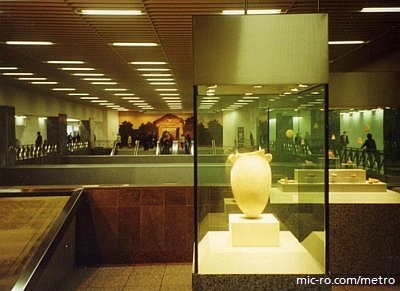
 Athens AthensThere are works of art in some of themetro stations. Some of the newer stations have even been turned into downright museums [tourtripgreece.gr], [ametro.gr].
Photo: The large upper concourse hall of Syntagma station (opened in the year 2000) with its murals and lots of archaeological displays.
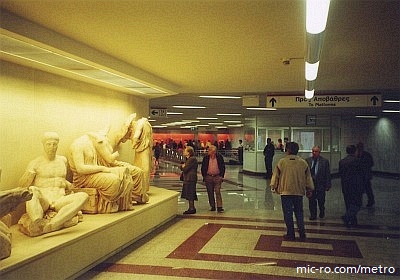
Photo: Replica of Parthenon friezes in the entrance hall of Akropoli station, which has been opened in 2000.
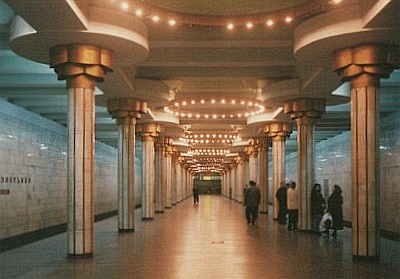
 Baku BakuThe capital of Azerbaijan boasts one line of a Soviet-style metro which was opened in 1967 and another line under construction.
Photo [metro.gov.az]: Platform level of Xalglar Dostlugu station built in 1989.
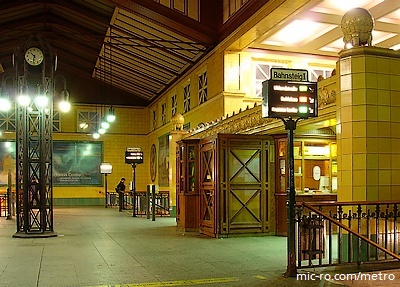
 Berlin BerlinSome of the early underground andelevated stations represent a style of metro architecture that was somewhat pioneering back then.The busiest architect of that era was the Swedish architect Alfred Grenander, who evolvedfrom a decorative style to modernism between 1902 and 1930 [untergrundbahn.de], [berliner-untergrundbahn.de].
Photo: Refurbished entrance building of Wittenbergplatz station, built in 1913 by Alfred Grenander.
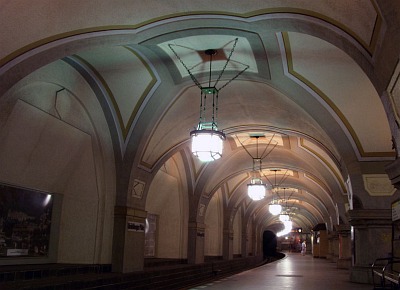
The co-financing of the U-Bahn line to Dahlem (called U3 today) by the posh district of Wilmersdorf facilitated a prestigious architecture in some stations.
Photo [Daniel Erler, absence-of-fear.de]: Heidelberger Platz station from 1913 by Wilhelm Leitgebel.
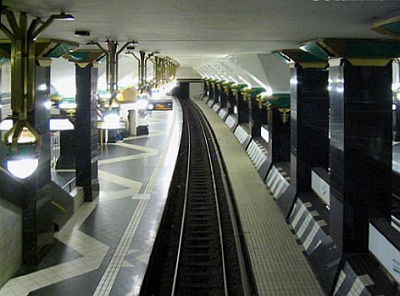
Most of the newer stations in Berlin are by Rainer G. Rьmmler. Designs range from 1960s Minimalist style and colourful 1970s Pop Art design to Postmodernism.
Photo [u-bahnbilder.de]: Postmodernist-style Rathaus Spandau station from 1984 by Rainer G. Rьmmler.

 Bilbao BilbaoMost new stations have been designed bySir Norman Foster in 1995. The underground stations have striking roofedglass entrances. They are nicknamed 'fosteritos' after the architectand shelter escalators or stairways [arcspace.com], [metrobilbao.net], [urbanrail.fotopic.net]. The corporate logo as well as the Rotis typeface, which isused for all signs and paperwork, are by Otl Aicher, 1989 [metrobilbao.net].
Photo: A fosterito at Abando station.

Foster about his spacious concrete vaults:
"A tunnel dug by man through earth and rock is a very special place. Its shape is a reaction to the forces of nature and the texture of its construction bears the seal of man. This must be respected, not covered up to make the place look like any other building. One must be able to feel being underground, and make it a good, special experience" (quoted from Metro Bilbao's
Touristic Guide Map).
Photo: Barakaldo station built in 2002.

 Boston BostonAmerica's first subway started toinclude works of art in stations in 1967 and continues to do so withnew stations. Murals, sculptures and other types of artworks have beenacquired through donations and art competitions [mbta.com].
Photo [Madhava Enros, madhava.com]: Ornate wrought-iron entrance structure built in 1917 at Copley station.

Boston is a little cheating with the Metro Silver line as it is just a bus line. They call it "a state-of-the-art rubber-tyred rapid transit system". High-tech buses run through tunnels like a subway and stop at architecturally interesting stations. In Courthouse station, double-height walls are covered with square panels of brushed steel [mbta.com].
Photo: Mezzanine level of Courthouse station built in 2004.
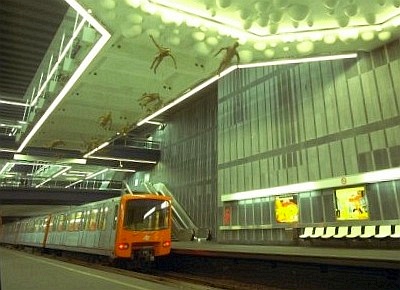
 Brussels BrusselsThe city encourages art in all metro stations [bsubway], [stib.irisnet.be].
Photo [C.A.I.D.]: Art installation with flying figures by Paul van Hoeydonck in Comte de Flandre station.

Photo [stib.irisnet.be]: "De Odyssee" sculpture by Martin Guyaux in Kruidtuin station.

 Budapest BudapestHungary's capital boasts the first subway on the European continent. Stations are clean, the ones on the 'Fцldalatti' line built in 1986 have been beautifully restored and some of the newer ones are also quite nice to look at.
Photo [Werner Huber, urbanrail gallery]: Oktogon station built in 1896.

 Buenos Aires Buenos AiresThe Subte (Subterrбneos de Buenos Aires) was opened in 1913 as the world's 12th metro system and the first in South America. Its stations and trains still preserve a good deal of the charm of the 'good old times'.
Photo [unknown origin]: Peru station from 1913 with its cast-iron columns and nostalgic atmosphere.
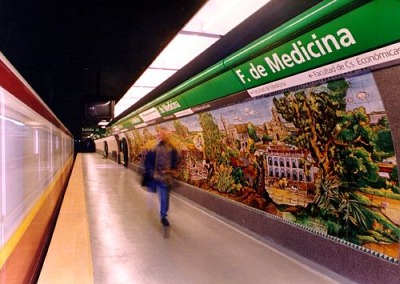
The stations in Argentina's capital are almost free of advertising, but instead contain a large number of murals.
Photo [metrovias.com.ar]: Facultad de Medicina station, opened in 1940.
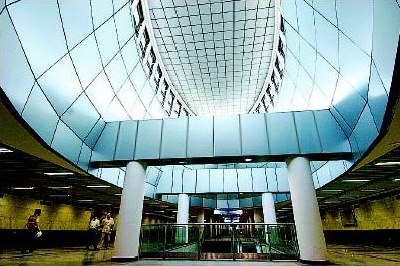
 Delhi DelhiIndia's capital has a clean and efficient metro system with some architecturally interesting stations underground as well as elevated. Works of art have been included in several stations [delhimetrorail.com].
Photo [Neeraj Paul, unknown origin]: Rajiv Chowk station built in 2005.
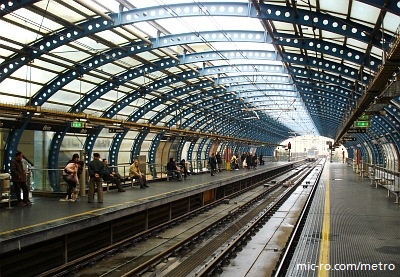
 Genoa GenoaThe elevated and underground stations ofthis small Italian metro system have been designed by the world-famous,Genoa-born architect Renzo Piano in 1983 [materia.it].
Photo: Brin station, which was opened in 1990.
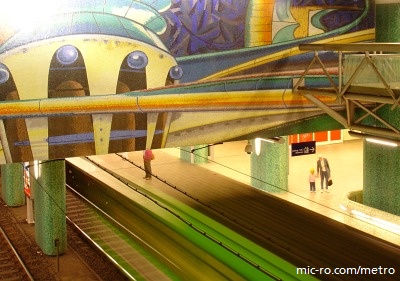
 Hanover HanoverMetro tram operator Uestra invitedworld-famous designers and architects to enhance the looks of the system. The 'Busstops' art project of 1992 resulted in nine remarkable bus and tram stops at street level [uestra.de (PDF)]. Jasper Morrison designed trains in 1997 and Uestra's headquarters is a twisted cuboid by Frank O Gehry.
Photo: Krцpcke station from 1975, once dreary, in 2000 completely refurbished with designs by Massimo Iosa Ghini.
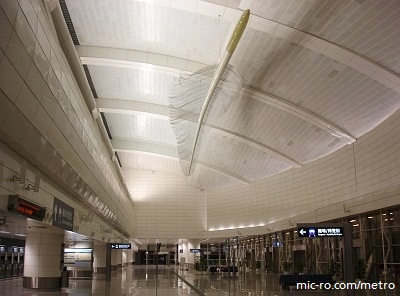
 Hong Kong Hong KongMetro art is not too obvious in Hong Kong, but MTR's
Art in Stations initiative brings works of art into the stations since 1998. There's an
Open Gallery project on the Island Line and in many of Hong Kong's metro stations, live performances and art exhibitions take place [mtr.com.hk].
Photo: Upper platform level of Tsing Yi station with 'Birds of a Feather' by Neil Dawson.
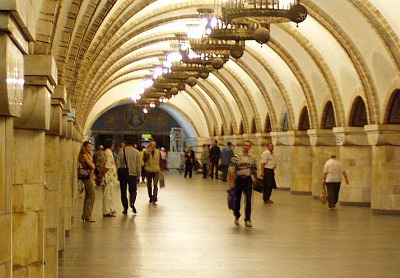
 Kiev KievThe capital of the Ukraine boasts a spectacular metro with three lines and stations similar to other cities in the former Soviet Union [metro.kiev.ua], [urbanrail.fotopic.net].
Photo [metropoliten.kiev.ua]: Platform level of Zoloti Vorota (Golden Gate) station.
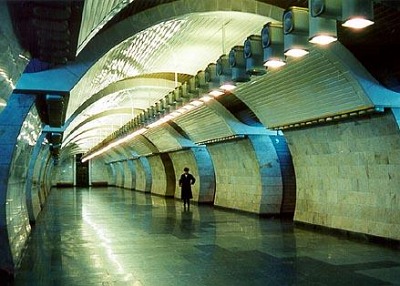
Kiev's stations are diverse in design. Apart from those in traditional soviet-style magnificence there are a couple of rather futuristic ones.
Photo [metropoliten.kiev.ua]: Platform level of Pecherskaya station.

 Lille LilleSince 1983 this city in Northern France has its VAL metro which is the world's most extensive driverless metro system. Many of the elevated stations are remarkable buildings.
Photo: Porte de Valenciennes station.
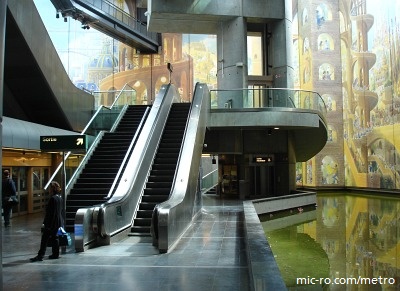
All metro stations in Lille are designed distinctly and come in a wide variety of architectural shapes. Most of the stations are underground. Many works of art can be found in Lille's VAL system, including sculptures and murals.
Photo: Platform level of Gare Lille Europe station with huge murals reflecting in a water basin.
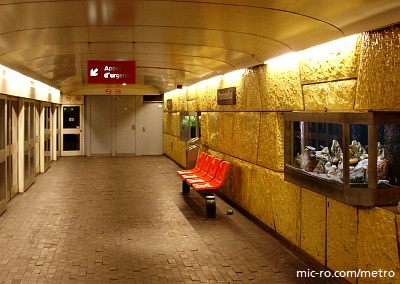
Building materials include different kinds of natural stone, stainless steel, wood, bricks or tiles. In one station (Montebello), live fish in aquariums at platform level provide an interesting distraction for waiting passengers.
Photo: Platform level of Montebello station with aquariums on the walls and wooden parquet flooring.
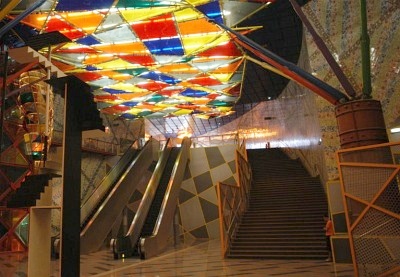
 Lisbon LisbonWorks of contemporary art have beenincluded in all metro stations [metrolisboa.pt 1]. Often are Portuguese tiles involved insome way [metrolisboa.pt 2].
Photo [David Pirman, nycsubway.org]: Platform level of Olaias station, which has been designed by the architect Tomбs Taveira and a group of artists.

Some stations in Lisbon are dedicated to themes. Parque station symbolizes the achievements of the Portuguese discoverers [inscrire.com].
Photo [unknown origin]: Parque station from 1994 on the Blue Line.
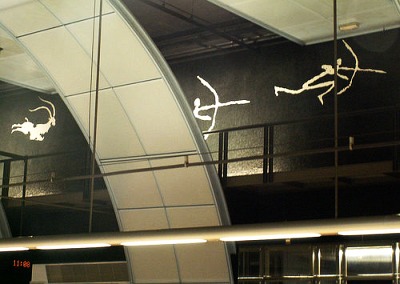
Cabo Ruivo station in Lisbon looks like a space station with its skeleton-like arches. The wall decoration, in contrast, resembles caveman paintings.
Photo [unknown origin]: The walls above the platform of Cabo Ruivo station on the Red Line.
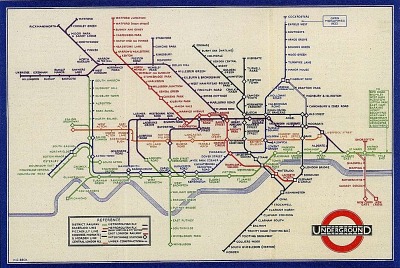
 London LondonLondon Underground ('Tube') was the world's first metro, and the first one tohave a corporate design. The design concept included the Johnstontypeface (Edward Johnston 1916), the roundel logo (Frank Pick 1918) andthe diagrammatic map (Henry C Beck 1933; click to enlarge). These design elements are still in use today almost unmodified [ltmuseum.co.uk] and have influenced the corporate designs of many other metros.
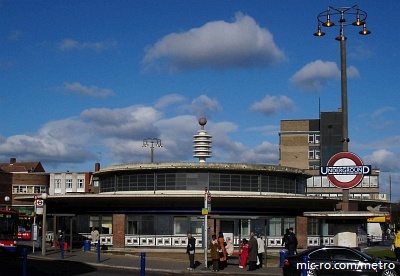
There are some examples of interesting stationarchitecture in London outside the city centre. Charles Holden isresponsible for the design of 50 underground stations as well as LondonTransport's headquarters at 55 Broadway [tube.tfl.gov.uk].For the Piccadilly Line stretch to Cockfosters, Holdendeveloped a modernist approach in the 1930s. The original art deco furnishing of that time is surviving in some of the stations.
Photo: The cylindrical entrance building of Southgate station built in 1933.
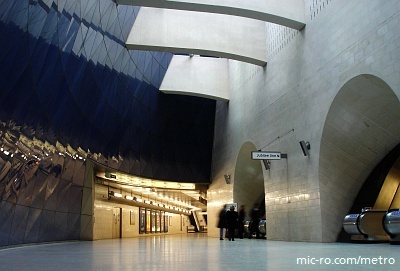
There are works of art in some of London's tube stations [tube.tfl.gov.uk]. The Jubilee Line Extension's spacious stations built in 1999have been distinctly designed by a couple of famous architects,including Foster & Partners, Ian Ritchie and Michael Hopkins [tube.tfl.gov.uk], [lrb.co.uk], [trainweb.org], [wilson].
Photo: The daylit intermediate concourse of Southwark station by McCormac Jamieson Prichard architects.

 Los Angeles Los AngelesThe city allocated 0.5% of subway construction costs to the creation of original art works. More than 250 artists contributed. There are works of art in all the stations of the Red Line and many other stations [metro.net], [mta.net], [usc.edu].
Photo [Eric Haas, nycsubway.org]: Hollywood/Highland station by Dworsky Associates architects and artist Sheila Klein.
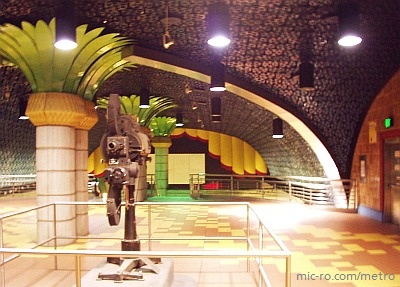
Hollywood/Vine station on the Red Line features Hollywood's golden history with original theater projectors from the 1930s presented like sculptures. Film reels cover the vaulted ceiling all over.
Photo: Hollywood/Vine station from 1999 by artist Gilbert Lujan and architect Adolfo Miralles.
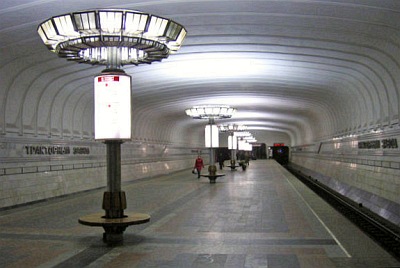
 Minsk MinskLike other metro systems in the former Soviet Union, the stations have been built using exquisite materials and a few are decorated with socialist-style reliefs.
Photo [Alexei Bobko, urbanrail.fotopic.net]: Traktorny Zavod station.

Several of the stations in Minsk seem to have a certain 'light-weight' feel that makes one forget that they are underground.
Photo [Alexei Bobko, urbanrail.fotopic.net]: Molodezhnaya station.

 Montreal MontrealMore than 50 stations are decorated with over 100 works of public art,such as sculptures, stained glass and murals by noted artists fromQuйbec. The city encourages this since 1967, one year after the opening of the system [stm.info].
Photo [Matthew McLauchlin, metrodemontreal.com]: Sculptures by Germain Bergeron at Monk station.

Some of Montreal's stations seem to be works of modern art themselves. Entrance buildings are often as well designed as the underground parts of the stations.
Photo [Matthew McLauchlin, metrodemontreal.com]: Acadie station (architects: Pierre Mercier, Pierre Boyer-Mercier, Patrice Poirier, artists: Jean Mercier, Michel Morelli, Mйtйore Design).

 Moscow MoscowThe metro opened in 1935. Many entrance buildings are just as architecturally spectacular as the stations below. Some stations are very deep and have been planned to serve as bunkers in case of war.
Photo [metro.ru]: Entrance building of Arbatskaya station on the first metro stretch from 1935.

Moscow's metro stations are a heritage of the socialist regime, originally intended to be 'palaces for the people'. With their marble-clad walls, chandelier lighting, and other precious interior, many indeed resemble palaces or cathedrals [metro.ru], [metrowalks.ru], [beeflowers].
Photo [cla.purdue.edu]: Central part of the platform of Komsomolskaya station built in 1952 on the circle line.
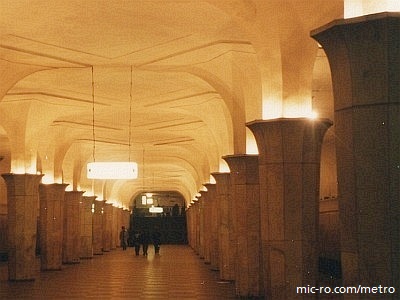
Many sculptures, reliefs and murals are found in the stations [metrosoyuza.net]. Besides Moscow, many metro stations in other cities of the former Soviet Union are of similar grandeur. However, the ones in Moscow are the most numerous and the most spectacular.
Photo: The platform of Kropotkinskaya station built in 1935.

 Munich MunichThis metro system has been opened in 1972 and hasspacious and clean stations. The earlier ones are rather minimalistic in designwhile the later ones got more interesting architectural features andsome works of art [oliverbarchewitz.de].
Photo: DьlferstraЯe station from 1993 by Peter Lanz and Jьrgen Rauch.

Photo: Westfriedhof station from 1998 with its simple concrete walls and its exceptional lighting concept by Ingo Maurer.
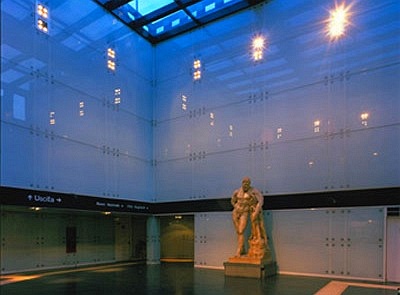
 Naples NaplesLine M1 has been turned into "Il Metro dell'Arte" as six stations have been upgraded with a lot of artworks [danpiz.net/napoli]. There are probably more stations to follow when the line is being extended.
Photo [metro.na.it]: Museo station.

 Newcastle NewcastleThe
Tyne and Wear Metro has a very consistently designed guiding system and several works of art in the stations [tyneandwearmetro.co.uk], [newcastle.gov.uk].
Photo [rwa.org.uk]: Interactive sculpture 'Pulse' of the year 2000 by Andrew Stonyer in the concourse level of Four Lane Ends station: Vibrations from approaching trains cause the neon light to pulse.

 New York New YorkSince the subway system was inaugurated in 1904, stations have been decorated with ornamented station name plates and signs. These ceramic wall decors come in a great variety and are found in abundance in almost all underground stations [Stookey, see Reference].
Photo [nycsubway.org]: One of the name tablets from 1904 at 42nd St/Times Square station.
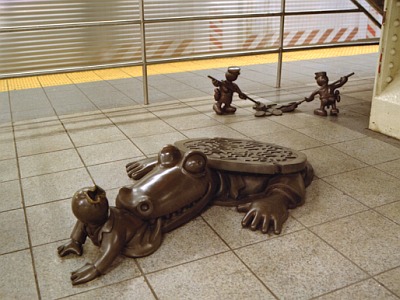
New York's subway system became somewhat neglected in the following decades, but recently, the 'Arts for Transit' program, founded in 1985, helped to remove the dreariness of the 1980s. The system now hosts more than 150 modern works of site-specific public art [tfaoi.com], [nycsubway.org], [mta.info], [steelcase.com (PDF)].
Photo [tomostudio.com]: Some of the many humourous bronze sculptures from 2002 by Tom Otterness in 14th Street station.
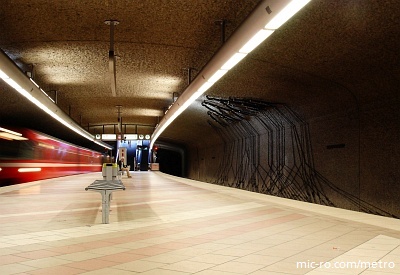
 Nuremberg NurembergGood overall architectural quality and some works of art in the stations [cityverkehr.de].
Photo: Schoppershof station with artistic, cobweb-like wire structures on the walls.
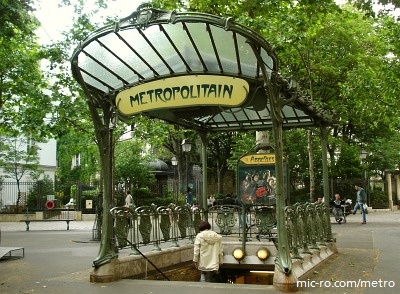
 Paris ParisThe distinctive, ornate, Art Nouveau metroentrances designed by Hector Guimard are a famous synonym for Paris's metro. Some are lost but 88 of them still exist [parisinconnu.com]. RATP gave reproductions to the subways in Chicago, Lisbon, Mexico City and to the Museum of Modern Art in New York, and an original one to Montreal [metrodemontreal.com].
Photo: The entrance at Abbesses station, designed in 1910, is one of the larger ones.
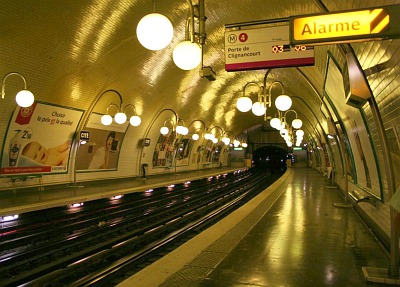
The elegant metro stations in Paris are mostly column-freevaults and look similar throughout the system, which was inaugurated in1900. Everything has been refurbished for the 100th anniversary.
Photo [Mike Nguyen]: Citй station on line 4.

An enjoyable architecture has also been implemented in Paris'snewest RER stations as well as in the new driverless metro line 14 (Mйtйor).
Photo: Magenta RER station with its interesting lighting.

 Portland PortlandMAX light rail in Portland, Oregon, USA, consists of three lines running on streets or on their own right of way. The operators have integrated one or more works of art in almost every station to promote transit usage and community pride [trimet.org].
Photo [trimet.org]: Illuminated metal trees designed by Portland artist Brian Borrello generate their own electricity from solar panels at Interstate/Rose Quarter station (opened 2004) on the Yellow Line.
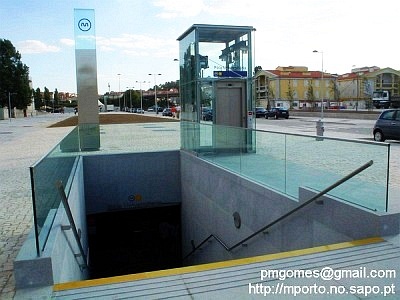
 Porto PortoThis city in northern Portugal got a light rail system in 2002. It runs partly underground and partly on street level. The rails are sometimes embedded in grass. Underground station architecture, surface-station furniture, signage and typography are quite consistent in their cool minimalistic elegance. Predominant materials are concrete, glass and steel [nunovski.fotopic.net].
Photo [mporto.no.sapo.pt]: Entrance of Pуlo Universitбrio station built in 2004.

Photo [mac.com/wkaemena]: Campo 24 de Agosto station built in 2004. During construction, a fountain from the 16th century has been discovered and excavated. It is now part of the concourse level of this station.
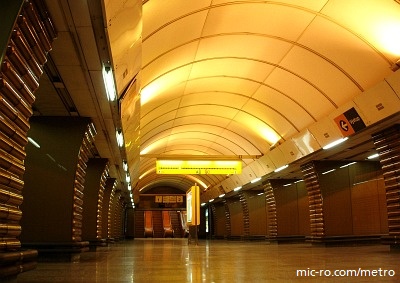
 Prague PragueSome of the stations seem to be ahomage to Victor Vasarely or kinetic artists of the 1970s. There are thousandfold repetitions of glass or aluminiumelements with all stations looking different.
Photo: Jinonice station built in 1988 on line B. Walls are covered with tube-shaped glass tiles.
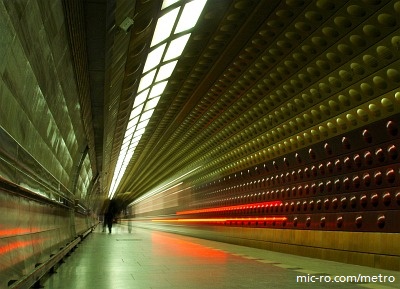
On line A, which wasopened in 1978, station walls are covered with aluminium tiles whichcome in three versions (convex, concave or flat) and in differentshades of colour. The designers thus managed to create a stunning,science-fiction-like appearance.
Photo: Flora station built in 1980 on line A.

 Pyongyang PyongyangThe capital of North Korea hosts a socialist-style metro with murals and a grand architecture [biglobe.ne.jp].
Photo [pyongyang-metro.com]: Platform level of Yonggwang station.

 Rhine-Ruhr Rhine-RuhrThe unique hanging monorail in the city of Wuppertal was opened in 1901 and runs above the Wupper river. Some old stations have been carefully restored and contrast in a nice way with rebuilt, architecturally interesting stations of the 1990's.
Photo: Landgericht station from 1903.
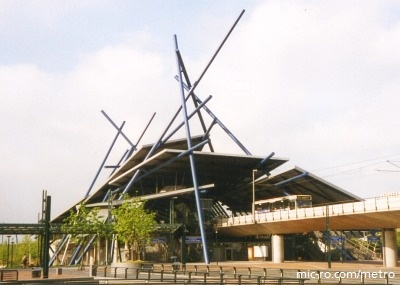
Rhine-Ruhr area is an agglomeration of about 30 cities in western Germany with some 20 metro-tram lines and 9 S-Bahn lines [jochen-schoenfisch.de].
Photo: The combined metro-tram and bus station Neue Mitte built in 1996 in the city of Oberhausen, a building obviously influenced by deconstructivist architecture.
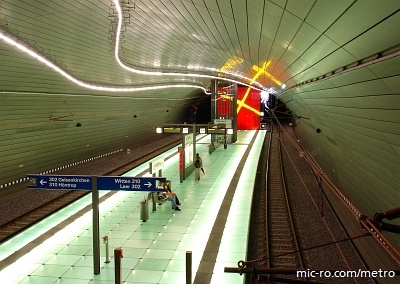
Photo: Lohring station from 2006 in the city of Bochum with a unique platform made of frosted glass, illuminated from below.
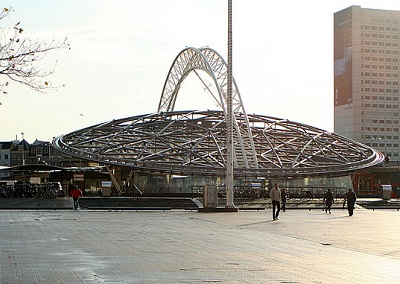
 Rotterdam RotterdamThis metro was opened in 1968 and has some stations with futuristic architecture or works of art.
Photo [Denis Kabanov, urbanrail.net]: Entrance building of Blaak station on the Calandlijn.

Other examples of interesting stations are Stadhuis (water flowing along vertical glass panels), Oostplein (glass windows in the floor) and some stations on the new Beneluxlijn [xs4all.nl/~kazil].
Photo [Robert Schwandl, urbanrail.net]: Wilhelminaplein station built in 1997.
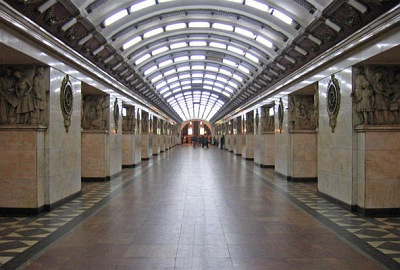
 Saint Petersburg Saint PetersburgOutstanding, palace-like stations similar to those in Moscow [metrowalks.ru], [metrosoyuza.net].
Photo [Alexei Bobko, urbanrail.fotopic.net]: Narvskaya station.
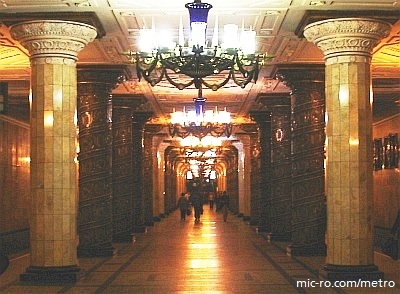
Most stations in Saint Petersburg are of excellent architectural quality.
Photo: Platform of Avtovo station.

 Santiago de Chile Santiago de ChileChile's capital has some metro stations with spectacular yet diverse modern architecture.
Photo [railway-technology.com]: Mirador station built in 1997.
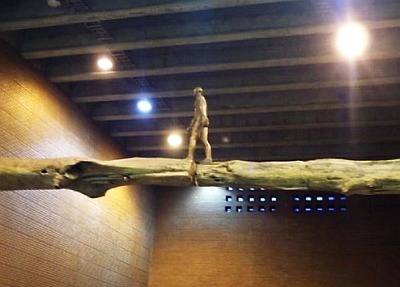
There are also lots of works of art in Santiago's metro, like giant murals and sculptures, especially on line 5 [metrosantiago.cl].
Photo [skyscrapercity.com]: Baquedano station holds the 15 m wide sculpture "El Puente" from 1999 by Osvaldo Peсa.
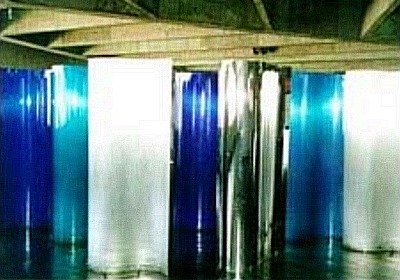
 Sao Paulo Sao PauloA diversity of geometrical forms were chosen for the underground stations [metro.sp.gov.br]. There's a collection of contemporary sculptures, installations and large murals in 30 of the 52 stations.
Photo [metro.sp.gov.br]: The mezzanine level of Brбs station boasts 25 curved steel and polyurethane plates (2.2 m x 1 m each) which form the art installation 'Kaleidoscope' from 1999 by Amйlia Toledo.

 Singapore SingaporeThe MRT has very clean stations, mostly with simple, modern designs. Increasingly, interesting architecture and works of art can be found.
Photo [Calvin Teo, wikipedia.org]: Exterior of Expo station, opened in 2002, on the East-West Line. The station has been designed by Foster and Partners in collaboration with Arup.

On the North-East Line, that was inaugurated in 2003, all stations have individual architecture, and works of art have been integrated in every station [app-stg.lta.gov.sg].
Photo [deliarts.net]: Ceramic murals and floor mosaics by Deliarts in the concourse level of Dhoby Ghaut station.

 Stockholm StockholmStockholm's subway is referred to as the world'slongest art gallery because works of art have been integrated in almost every station since the 1950s. SL spends 10 million SEK per year in safeguarding and developing artwork.
Photo [from SL's free metro art booklet, see Reference]: Platform of T-Centralen station on the Blue Line, designed by Per Olof Ultvedt in 1975.
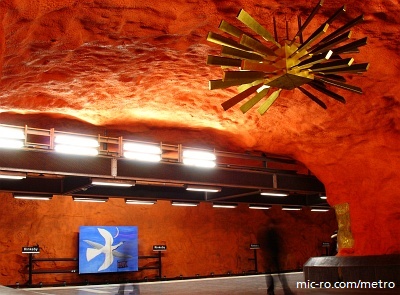
Many stations in Stockholm have been left as rock caverns, especially on the Blue Line, which gives them an outstanding, unique atmosphere. Works of art can be found in 90 of the 100 stations. 140 artists have contributed so far.
Photo: Rinkeby station built in 1975 on the Blue Line with gold mosaics, paintings, and sculptures.
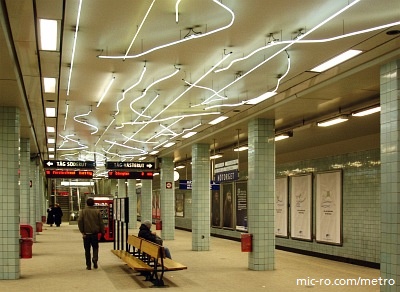
Photo: Neon sculpture by Gun Gordillo in the ceiling of Hцtorget station from 1998 on the Green Line.

 Tashkent TashkentTashkent's metro built in 1977 as one of the most beautiful of the former Soviet Union consists of three lines. Leading architects and artists from Uzbekistan took part in creating the stations, some in Islamic designs.
Photo [ilkhom.ferghana.ru]: Ceiling of Navoiy station from 1984.
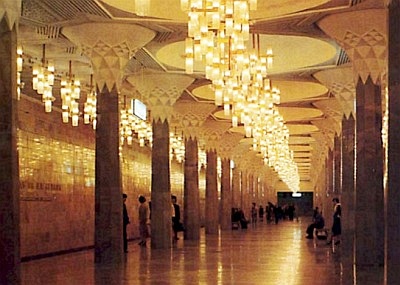
Enduring materials have been used for Tashkent's station interiors, like engraved metal, glass, granite, marble, or carved alabaster. Each station's design is distinct and devoted to a certain theme.
Photo [crafts.freenet.uz]: Mustaqilik Maidoni station from 1977.
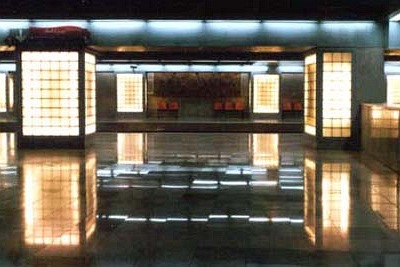
 Tehran TehranThe clean metro system in the capital of Iran has many stations with an interesting architecture or design.
Photo [tehranmetro.com]: Platform level of Mirdamad station from 2002.
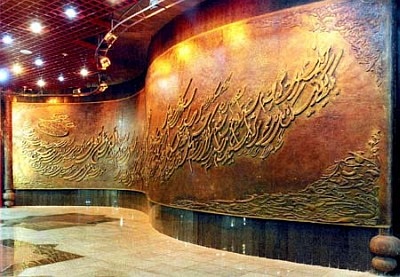
There are many works of art integrated in the stations [tehranmetro.com], [iranchamber.com].
Photo [cyberpersia]: Concourse level of Imam Khomeini interchange station, which has been opened in the year 2000.

 Tokyo TokyoAll stations on Tokyo's Oedo line (opened in 2000) have been created by different well reputed architects, selected through a design competition [g-mark.org], [makoto-architect.com], [jrtr.net (PDF)]. The organic designs on platform and street levels of Iidabashi station are the world's first examples of computer-generated "evolutionary architecture" as architect Makoto Watanabe describes it in his book (see Reference).
Photo [gandamu]: Entrance of Iidabashi station.

 Toronto TorontoMost stations are looking more or lessalike, except for the colours of the wall tiles. But recently, many works of art have been integrated [city.toronto.on.ca], [transit.toronto.on.ca 1], [transit.toronto.on.ca 2]. The
Arts on Track Project aims to revitalize stations [tcf.ca].
Photo [Craig James White, flickr.com]: One of the many optical illusions at Bayview station by artist Panya Clark Espinal.

 Valencia ValenciaThis metro in Spain has several very different stations with interesting architecture.
Photo [calatrava.com]: Alameda station, designed by the architect Santiago Calatrava.
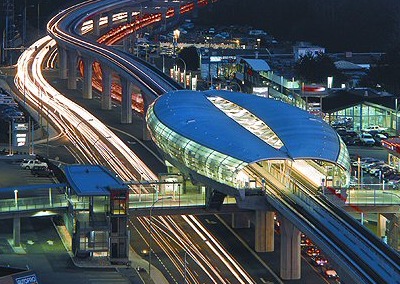
 Vancouver VancouverVancouver's LRT is called SkyTrain as it runs elevated except for four underground stations in downtown. The Millennium Line extension built in 2002 includes a couple of interesting stations which incorporate organic designs, west-coast wood architecture and modern metal-and-glass designs.
Photo [archiseek.com]: Brentwood station, designed by Peter Busby+Associates architects.

 Vienna ViennaThe art-nouveau Stadtbahn stations have been consistently planned by the renowned architect Otto Wagner and date backas far as 1898 when the city rail system was inaugurated [wiennet.at]. Most of them have been beautifully renovated and integrated into the metro system.
Photo [bigfoto.com]: Karlsplatz station pavilion built in 1898
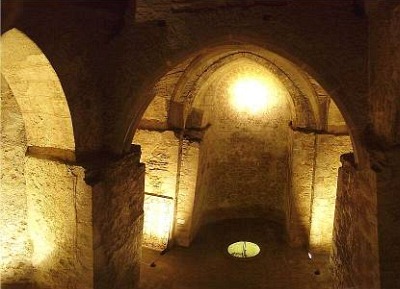
During tunnel construction for Vienna's metro, many objects have been excavated, some of which are now displayed in several stations [planet-vienna.com].
Photo [wien-diashows.com]: The excavated Virgil chapel under the Stephansdom, dating back to 1250, can be seen through windows from the concourse level of Stephansplatz station.
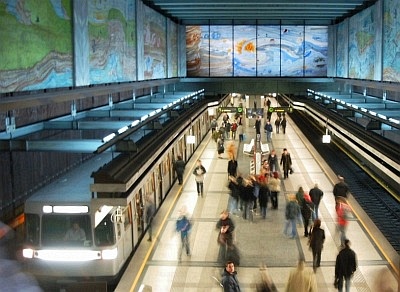
Some of Vienna's elegant modern metro stations are decorated with works of art.
Photo [hs-st-paul.ksn.at]: Volkstheater station with mosaic friezes by Anton Lehmden.

 Washington WashingtonThe Metrorail system of the UScapital has been designed by Harry Weese & Associates to beAmerica's grandest subway and was inaugurated in 1976. The Commission of Fine Arts, which had toapprove the design, favoured the station design with coffered vaults [chnm.gmu.edu], [railwayage.com].
Photo: Capitol South station.

Works of art can be found in many stations [wmata.com/about/]. All stations above ground in Washington, as well asthe underground ones, have been constructed using the same selection of materials consistently throughout the system. A unique detail are the rows of lamps on all platform edges which start flashing when a train approaches.
Photo: Arlington Cemetery station.

 Zurich ZurichSome of the underground and at-grade S-Bahn stations have interesting architecture.
Photo [Donald Corner and Jenny Young, greatbuildings.com]: The organic concrete structure of Stadelhofen station built in 1990 by architect Santiago Calatrava.
All photos by M. Rohde except where indicated otherwise.
More sections of
Metro Bits:
HomeMetros with a ViewWorld Metro ListMetro LogosAnnouncementsMetro ResourcesFAQAbout
Bennett, David:
Metro: The Story of the Underground Railway. Octopus 2004.
Hackelsberger, Christoph:
U-Bahn-Architektur in Mьnchen. Prestel 1997.
Powell, Kenneth:
The Jubilee Line Extension. Laurence King 2000.
Railway Technical Web Pages:
Station Design.
Rauch, Jьrgen:
The Architecture of Underground Railway Stations. Krдmer 1996.
Stockholm SL:
Art in the Stockholm Metro. 2001 (free booklet).
Stookey, Lee:
Subway Ceramics. A History and Iconography. 1992.
USA Today 9/2/2004:
10 Great Places to Stop for Subway Art.
Watanabe, Makoto Sei:
Induction Design. A Method for Evolutionary Design. Birkhдuser 2002.
 - +4

Просмотров: 9 896 | Категория: Интересные фоторепортажи
Коментариев: (0) Оставить свой Комментарий
|



 Athens
Athens

 Baku
Baku

































 Moscow
Moscow















































